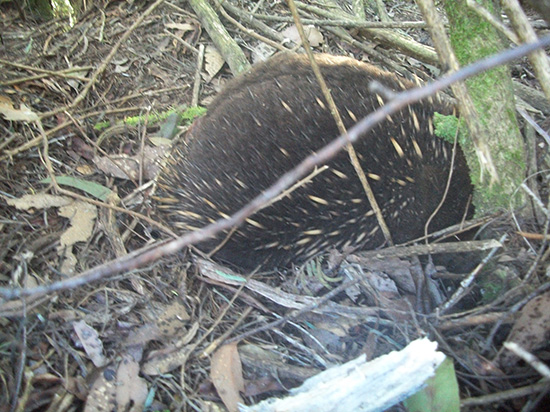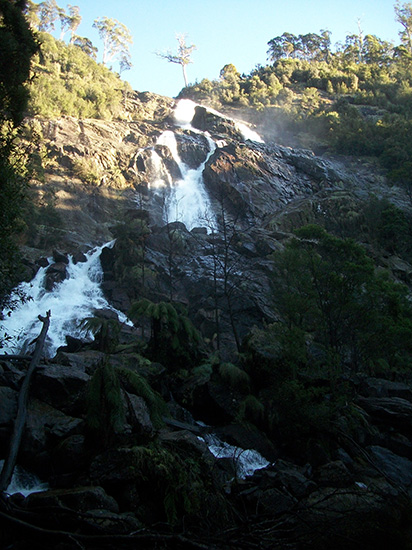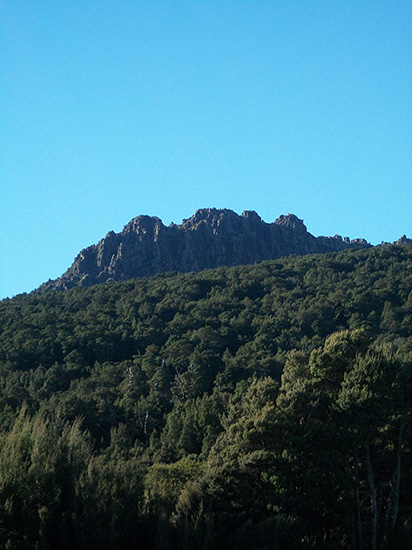From the Field: Bill Buck in Tasmania
Posted in Bill Buck, From the Field, Science on July 20 2011, by William R. Buck
Ed. note: The blogging bryologist, Mary Flagler Cary Curator of Botany, Bill Buck, is back! This time, Buck is reporting from Tasmania where he is researching mosses for a week before flying to Melbourne for the International Botanical Congress.
July 15, 2011; Hobart, Tasmania, Australia; final entry
Once again we awoke to a frost, this one so heavy that it almost looked as if it had snowed. We assumed that the frost would not be in the forest, and we were right. Our first scheduled stop was not too far away, along a trail leading to a view of St. Columba Falls. The falls are named for an Irish Catholic saint who copied the Psalms around 500 A.D., which started a war, and who was then exiled to Scotland. The falls were named by an Irish woman who discovered them and who had herself been exiled to Tasmania.

On the way to the site we finally saw an echidna, a porcupine-like marsupial. We slammed on the brakes, only to have the only other car we saw all morning blow its horn at us. Nevertheless, we scrambled out of the car to get a better look at this strange little animal. Like an ostrich, it had buried its head in the leaf litter, presumably thinking that if it couldn’t see us then we couldn’t see him. It was great to see this odd Australian animal. The only animal we didn’t get to see that we really wanted to was a wombat.

But duty called, and leaving our new friend behind, we headed up the road to the falls. Because St. Columba Falls is a popular tourist destination (just not first thing in the morning on a winter weekday), we were cautioned not to leave scars from our collecting along the trail. It’s just a short walk to the falls, which is one of the highest in Australia. Although I only found a single moss that I hadn’t seen previously on the trip, I found that many of the mosses I had seen sterile at other sites were fertile here. I collected these judiciously so as to have them as reference material in the herbarium.
After the falls, we made a non-botanical stop. This region of Tasmania is known for its local cheeses, so we stopped at a small shop/café which makes its own cheese. After a tasting of the three different ages of their cheddar, we got lunches to go (which, of course, included cheese). I even bought a wedge to try to carry back home (that is, if I don’t eat it first).
Cheeses sampled, we returned to our mission of moss collecting. Our next stop was the Mount Victoria Forest Reserve where we hiked up the southwest slope of Mt. Victoria. After walking through a low, swampy area, we entered a very shady southern beech rain forest. Even though it was midday, the dense canopy made the forest incredibly dark. Paddy said it wasn’t much better in mid-summer. At first, it was hard to even use our hand-lenses because the light levels were so low. But our eyes slowly adapted, and as we ascended the mountain it seemed to get somewhat lighter as the forest understory became more open.

Our goal had been to reach tree line, but we never made; our pace of ascent while collecting was just too slow. Despite the dimness of the forest, I was still able to find a number of mosses that I hadn’t seen previously on the trip. One particularly interesting find, that I initially thought was a liverwort because I could scarcely see it with my hand-lens in the near-darkness, turned out to be a Distichophyllum. Higher up, where the light was better the collecting improved. I don’t know if it truly was more diverse higher up the slope, or if it was just that I could see better.
During this entire time, Paddy, James, and I were within sight of one another, but Mike had run ahead and none of us had seen him since we left the car. I knew that Mike was an avid rock-climber and it turns out that he had galloped up above tree line to see the options. Apparently it was mostly bouldering rather than real rock climbing (and Mike didn’t have any equipment). We had agreed to meet back at the car by 2 p.m., and the three of use arrived there and had our lunch. Mike had not yet appeared and we started getting concerned that he might have gotten lost because the trail was not well marked. About 2:30 we blew the horn and a short time later, we heard what sounded like someone running. The next thing we knew, Mike burst out of the trailhead and came running toward the car, shirtless, but obviously exhilarated. He had become lost for a short while, explaining his tardiness. I did ask if he had collected anything and was disappointed when he said that he hadn’t had time to do so.
We had one more stop in mind, a place that Paddy had never visited, but which had been recommended to him by colleagues. It was supposed to be a southern beech forest with Sphagnum carpeting the forest floor. After driving quite a while we reached what appeared to be the right place, but the forest was eucalyptus, not southern beech. We decided that we had no shortage of collections and would not be disappointed to miss one last collecting site. So, we turned the car around and headed back to Hobart. As we drove down otherwise deserted gravel roads, wallabies of various kinds regularly jumped out across the road in front of us. As evidenced by all the wallaby road-kill we passed, this is obviously not an uncommon phenomenon.
Finally though we reached paved roads and headed to Hobart. We have mixed feelings about returning. Paddy’s generosity with his time provided us with such a wonderful collecting trip that we are sorry to see it come to an end. On the other hand, James and I both have hundreds of collections that will now keep us busy for weeks back in New York.
We set the next day, Saturday, aside for touristic activities. James and I wanted to visit bookstores to see if we could find some botany books for the Mertz Library at the Garden (and cookbooks for my personal collection). At both bookstores where I made major purchases, I was fortunately able use the Internet to verify that we didn’t already have copies of the books in the Library that I wanted to buy. Even with the Library’s excellent collections, I was able to find over a dozen publications we didn’t already have. The NYBG Library is so good in part because of the efforts of my predecessors, so I feel obliged to improve it for my successors. With backpacks filled with as much as we could carry, we headed back to our hotel. On the way, we came to a Turkish restaurant and decided to lunch there because neither James nor I had ever had Turkish cuisine. We got an assortment of appetizers and were both really impressed with how tasty it all was–certainly our best meal in Tasmania.
On Sunday morning James and I will fly to Melbourne to attend the nomenclature sessions that precede the International Botanical Congress. Mike will spend another week in Tasmania, and Paddy gets a week of his life back, before they will both fly to the IBC.
It’s hard to imagine our time in Tasmania could have been any better (in large thanks to the efforts of Paddy) and it is with regret we leave for the Australian mainland.
To support Bill and the Garden’s other scientists in their plant science research efforts, please donate now and help support these expeditions and studies.
Bill Buck’s Previous Reports From the Field:
July 14, 2011; Pyengana, Tasmania, Australia
July 13, 2011; Weldborough, Tasmania, Australia
July 12, 2011; Hobart, Tasmania, Australia
July 11, 2011; Hobart, Tasmania, Australia
February 8, 2011; Punta Arenas, Chile
February 5, 2011, unnamed sound northwest of Isla Georgiana
February 4, 2011, unnamed sound directly east of Seno Mama, Chile
February 2, 2011, Seno Courtenay, northern arm, Chile
February 1, 2011, Seno Courtenay, Chile
January 31, 2011, Canal between Isla Georgiana and Isla Clementina,, Chile
January 30, 2011, Unnamed sound on south side of Brecknock Peninsula, NW of Isla Georgiana, Chile
January 29, 2011, Isla Aguirre, Seno Quo Vadis, Chile
January 26, 2011, Punta Arenas, Chile
January 24, 2011, Seno Chasco, just north of isthmus to Brecknock Peninsula, Chile
January 23, 2011, Isla Grande de la Tierra del Fuego, Puerto Consuelo, Seno Chasco, Chile
January 22, 2011, Isla Grande de la Tierra del Fuego, Seno Brujo, Chile
January 21, 2011, Isla Grande de la Tierra del Fuego, Seno Brujo, Chile
January 20, 2011, Isla Grande de la Tierra del Fuego, Seno Bluff, Chile

